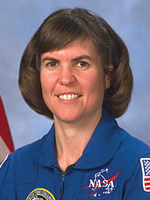Janice E. Voss
Payloads Lead, Astronaut Office,
NASA Johnson Space Center
BS Engineering Science ’75
In recognition of her pioneering and record-setting achievements in the U.S. space program and her commitment to engineering and science education
Adaptability, it seems, is a key trait in becoming an astronaut. Janice Voss, who died of breast cancer on Feb. 6, 2012, said her ability to adapt served her well through a “chaotic” professional development program at the Massachusetts Institute of Technology where two of her thesis advisors passed away, two others left the university after not receiving tenure, and even a couple of the programs she was accepted to were canceled.
An overall commitment to science and engineering excellence made Voss a standout among 1,945 qualified individuals who applied to NASA’s Astronaut Program for the 1990 class. Purdue’s first female astronaut, Voss has flown in space five times, travelling a total of 18.8 million miles in 779 orbits over 49 days.
What is her biggest thrill about gliding through space? Not so much the view of the globe, but a chance to be part of a stellar team. “It’s an amazing feeling of belonging,” Voss says. “Everyone is working together with the same goals.”
In her first flight on the shuttle Endeavour in 1993, Voss supervised 22 experiments in the SpaceHab, the world’s first commercial laboratory module in space. In 1995, she operated Discovery’s robot arm. She was payload commander in charge of 33 experiments on Columbia, which went into space twice because of technical problems in 1997. And she served as payload commander again on Endeavour in 2000 during an 11-day mission that sought to measure earth’s topography precisely.
Voss says these otherworldly accomplishments were first inspired by Madeleine L’Engle’s A Wrinkle in Time, a science fiction novel she picked up at the public library in Madison, Ind., while visiting her grandparents’ farm as a sixth-grader. A native of Rockford, Ill., she attended Purdue and graduated from the last engineering sciences class, which appealed to her because of the opportunities for interdisciplinary exploration.
Taking part in the co-operative education experience, Voss began working at NASA as an undergraduate at Purdue. “I would take a course and use it the next semester at NASA,” she says. “Or I would do something at NASA and it would then show up in my coursework. That interplay of work and schoolwork made everything so much more interesting and exciting for me.”
She is also excited about the future of spaceflight, in spite of the current climate. “I’m very encouraged,” Voss says. “I’m of the camp that says we’re going to have to get to commercial flight in order to get the prices down and get everyone involved. It sure seems like we’ve got some players in there that are doing the right thing.”
A longtime spokesperson for the space industry and the ultra-importance of a math and science education, Voss returns to Purdue often to speak to students in the Women in Engineering Program. She is also living history that is now part of the Susan Bulkeley Butler Women’s Archives, which was established in 2006 to document the pioneering women who helped shape Purdue and Indiana history.
Career Highlights
| 2007-present | Payloads Lead, Astronaut Office, NASA Johnson Space Center |
|---|---|
| 2004-2007 | Science Director, NASA Kepler Spacecraft Project, NASA Ames Research Center |
| 1990-2004 | Mission Specialist, NASA Astronaut Corps |
| 1987-1990 | Mission Integration Lead, Orbital Sciences Corporation |
| 1987 | PhD Aeronautics and Astronautics, Massachusetts Institute of Technology |
| 1983-1987 | Draper Fellow, Draper Laboratory, Massachusetts Institute of Technology |
| 1978-1983 | Graduate student, Rice University and Massachusetts Institute of Technology |
| 1977-78 | Shuttle Entry training instructor, NASA Johnson Space Center |
| 1977 | MS Electrical Engineering, Massachusetts Institute of Technology |
| 1975 | BS Engineering Sciences, Purdue University |

